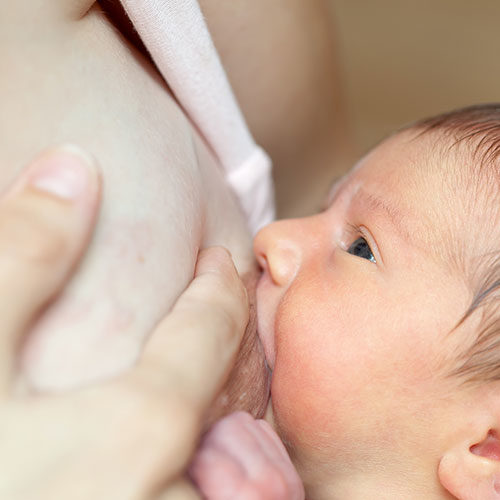What is Child-Led Weaning?
As the name suggests, child – led weaning means that the child’s needs and wishes are followed over anything else while weaning the child. This is also called self-weaning. It means that the child is breastfed until she outgrows the need for it. Another increasingly used term is ‘natural term weaning’; which again implies that the process of weaning does not involve any external interventions and takes place completely naturally.
Why breastfeed to term?
Breastfeeding is a biological norm. Mammals nourish their young through their breast milk and nature has not intended for a time-limit to be imposed upon the young by the mother. In all other species of mammals, the babies gradually wean from breast. It happens naturally and organically. All human babies at one point too nursed to term and self-weaned as they outgrew the need to nurse.
WHO recommends breastfeeding for a minimum of 2 years and beyond. There is no upper limit indicated. There are innumerable positives of nursing a baby to term. Some, of many, are listed below..
- As the child grows up, the mother’s milk may diminish in quantity (as the baby heavily depends on solids), the composition of breast milk changes and it becomes more dense with nutrients.
- The longer a child is breastfed, the more her immunity is boosted.
- Research has shown that each year of breastfeeding reduces the risk of invasive breast cancer in mothers.
- Breastfeeding for more than 2 years reduces the mother’s risk of developing type-2 diabetes.
- Studies have shown better cognitive development in children with longer duration of breastfeeding.
- It can be a blessing during illnesses when the child refuses solids. Breast milk can become the primary source of nutritional needs and hydration of the child.
When does natural term weaning occur?
- It is said that a child who is nursed on demand gradually outgrows the need to breastfeed as she becomes more and more dependent on solids for all her nutritional needs and as she becomes secured enough emotionally to be able to let go of comfort nursing as well. This typically happens between the age of 3 and 7 years. Some children might wean a little earlier than 3 years whereas some might go on to nurse for longer than 7 yeast as well.
Creating a supportive environment for natural term weaning:
- Supporting the mother –
- When a mother has access to knowledge and information about breastfeeding, she is more likely to continue nursing for a longer time.
- When a mother feels comfortable nursing her older child in the presence of her support system, she is more likely to continue nursing her child for as long as the child desires.
- It is important that the mother feels supported and encouraged by her medical support system as well. This includes her GP, paeditrician and other healthcare providers.
- The community at large should be supportive of breastfeeding.
- Supporting the child –
- When the child is always nursed responsively, the child gains the emotional security in her breastfeeding relationship with her mother.
- Child should never be shamed or punished for expressing her need to nurse.
- Direct or indirect interventions should be avoided.
How to cope along the journey of natural term weaning?
It can be exhausting and overwhelming to nurse a toddler when it’s the path of natural term weaning one has embarked upon. It is important to acknowledge the mother’s needs from time to time while not ignoring the child’s needs. Following guidelines can be handy to cope on tough days.
- Setting boundaries –
It is important to understand that this is different from gentle mother-led weaning as here, the focus is not on cutting down the nursing sessions. The focus is on increasing and enhancing the mother’s comfort level. Also, these boundaries are set very gradually over time and with children above the age of 3 years. They can be talked and reasoned about with the child. Some commonly used boundaries are as follows..
- No more nursing outdoors. This includes parks, cafes, malls etc.
- No more nursing just because of boredom. It can also help the child identify her moods and encourage her to find ways to keep herself engaged in activities.
- No more nursing at meal times.
- Not giving up on a bad day –
Sometimes, the going can get really tough. A mother might feel extremely overwhelmed and touched out. It is important to address these feelings if they persist. And if weaning can help her feel better, it should be considered. However, a bad/tough day here and there may not call for such drastic measures.
- Talk to the child when you are overwhelmed –
Children can be reasoned with. Also, children who are secured in the breastfeeding relationship are less resistant to give up on a couple of feeds once in a while, if they are explained why it is required. Talking to the child when the mother needs a break on tiring days is a great technique to pause and cope.
References:
https://www.llli.org/breastfeeding-info/weaning-how-to/
https://kellymom.com/ages/weaning/considering-weaning/how_weaning_happens/
https://www.naturalchild.org/articles/guest/ruth_kamnitzer.html
https://themilkmeg.com/nine-reasons-my-child-is-not-too-old-to-breastfeed/
https://www.breastfeeding.asn.au/bfinfo/weaning-toddlers
https://www.parents.com/baby/breastfeeding/tips/benefits-of-extended-breastfeeding/
Wish to speak with a member of our team who is a certified lactation professional and also an experienced breastfeeding mother, click on this link.
Medical Advice Disclaimer
THIS WEBSITE DOES NOT PROVIDE MEDICAL ADVICE.
The information, including but not limited to, text, graphics, images and other material contained on this website are for informational purposes only. No material on this site is intended to be a substitute for professional medical advice, diagnosis or treatment. Always seek the advice of your physician or other qualified health care provider with any questions you may have regarding a medical condition or treatment before undertaking a new health care regimen, and never disregard professional medical advice or delay in seeking it because of something you have read on this website.
Disclaimer
We understand and acknowledge that parents and babies can be of various genders on a spectrum of LGBTQI+. Families come in diverse flavours. However, in our articles, for the sake of simplicity and convenience, we will be referring to the breastfeeding parent as the mother and using the female pronouns- ‘she’ and ‘her’ for babies. Babies can be nourished and nurtured in different ways and while we have used the terms breastfeeding and nursing, we recognize that parents can opt to chest feed or finger feed.
We don’t have conflicts of interest and declare, and we are compliant with the WHO code of marketing of breastmilk substitutes and the IMS act.
In case you find any information on this website that needs to be updated, please write to us at info@bsim.org.in






